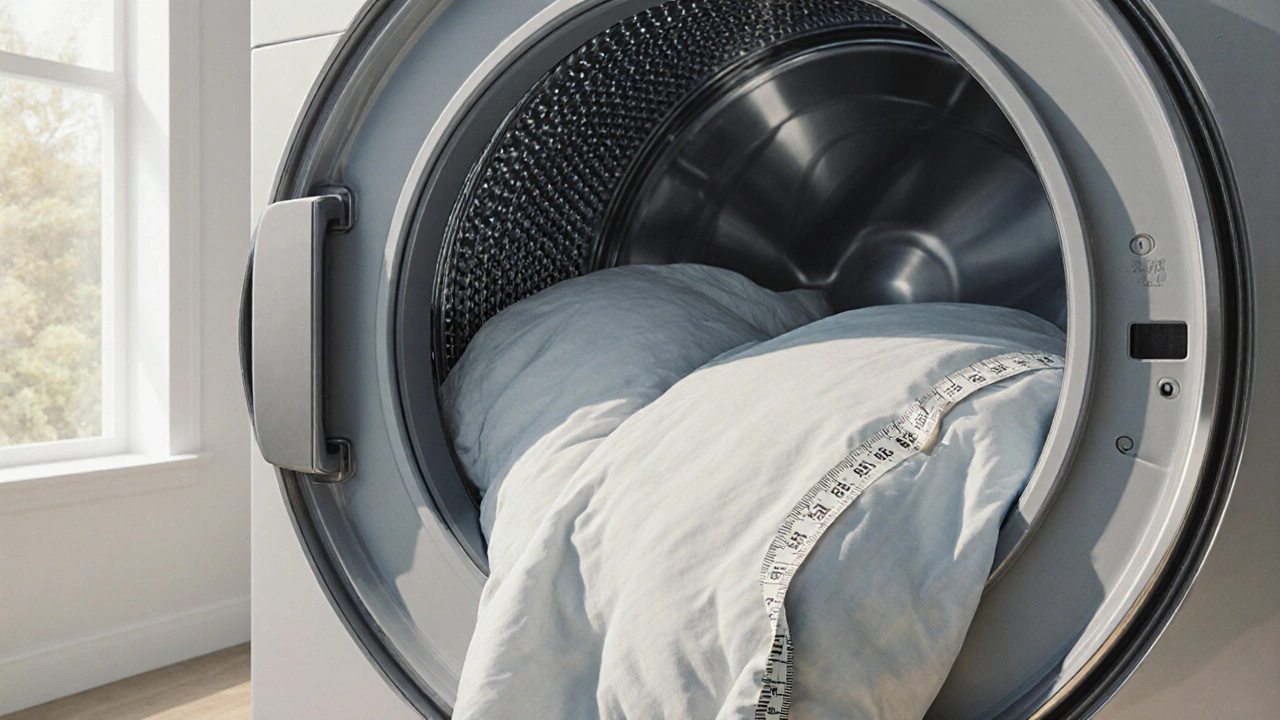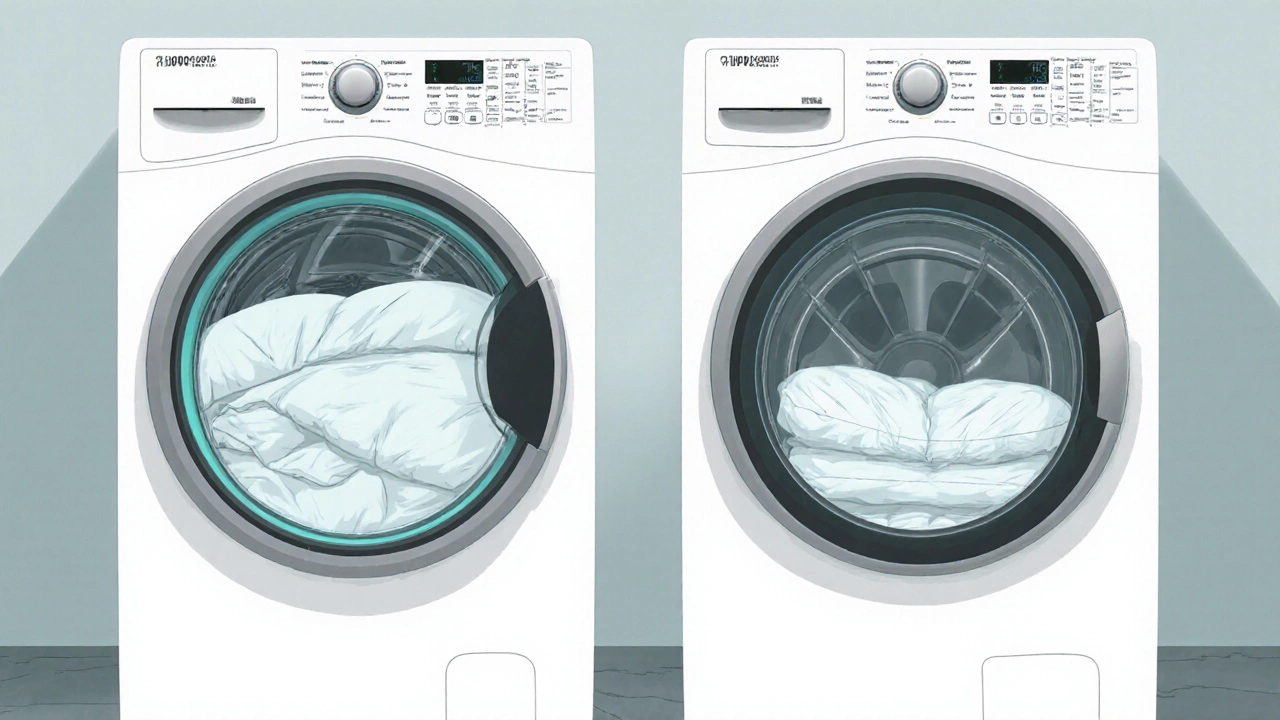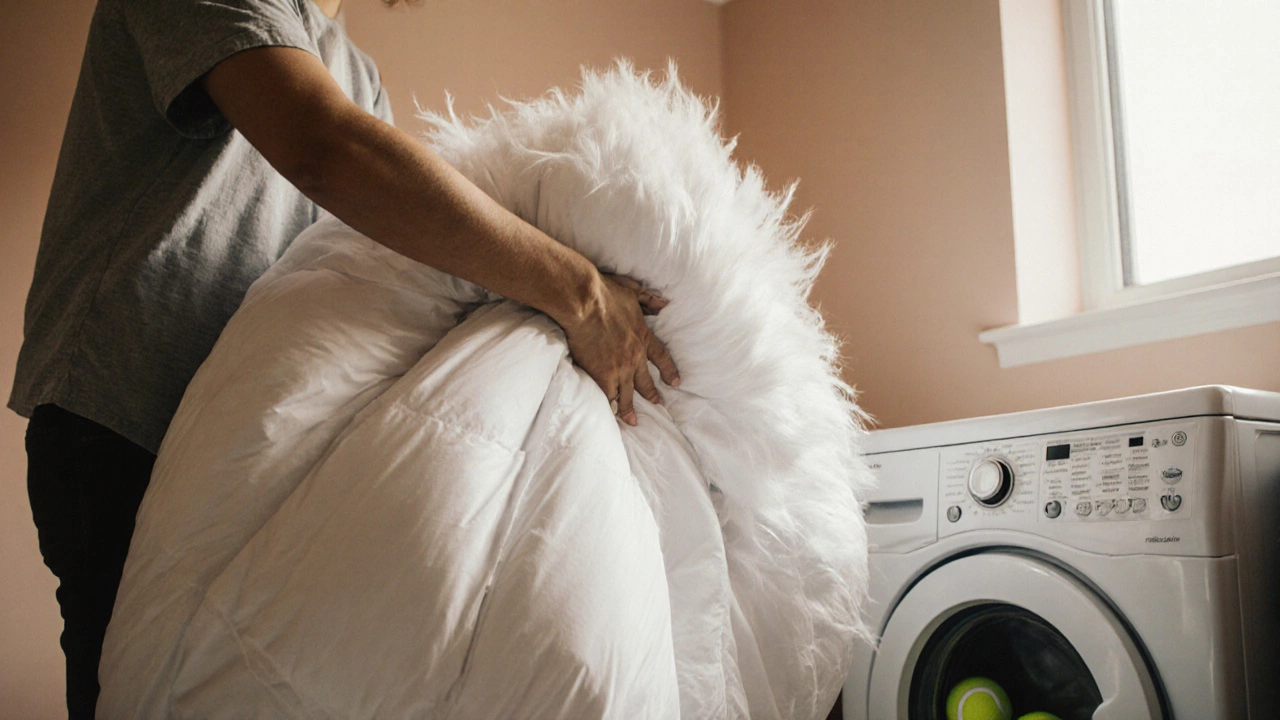
King-Size Comforter Washer Capacity Calculator
Compatibility Result
Key Takeaways
- A washer that handles at least 4.5cuft (≈10kg) is safe for most king‑size comforters.
- Front‑loading machines usually give you more usable space than top‑loaders of the same rating.
- Measure your comforter’s dimensions and weight before buying a washer.
- Use a gentle cycle, low spin, and a detergent made for bulky items.
- If the comforter barely fits, consider a laundromat drum of 5cuft or larger.
When it comes to cleaning that king‑size comforter, the first question most people ask is: "Will my washer fit?" The answer lies in understanding the relationship between the comforter’s size, its weight, and the washer capacity. This article walks you through the math, the machine types, and the practical steps you need to get that fluffy bedding clean without stretching or damaging it.
1. What Is Washer Capacity and Why It Matters
Washer capacity is the amount of laundry a machine can handle in a single cycle, usually expressed in cubic feet (U.S.) or kilograms (European). It tells you how much volume the drum can accommodate before the clothes start to press against each other, which can lead to uneven cleaning or wear.
In the UK, manufacturers often list capacity in kilograms. A 7kg machine typically corresponds to about 3.5cuft, while a 10kg model is roughly 4.5cuft. The bigger the drum, the more room for bulky items like a king‑size comforter to tumble freely.
washer capacity is the keyword you’ll see repeated in spec sheets, and it’s the metric you’ll compare against the size of your bedding.
2. Measuring a King‑Size Comforter
A standard UK king‑size comforter measures about 230cm×220cm (90in×86in). However, the actual dimensions can vary by brand, and the weight ranges from 2kg to 4kg or more depending on fill material.
To get an accurate idea of the space it will occupy in the drum, follow these steps:
- Lay the comforter flat on a clean floor.
- Measure the length and width with a tape measure.
- Weigh it on a household scale (or use the manufacturer’s spec).
- Calculate the approximate volume:
Volume ≈ (Length×Width×Thickness). For a typical 2‑cm thickness, a king‑size comforter occupies roughly 0.92cuft.
Even though the volume seems small, the comforter’s shape makes it hard to compress, so you’ll need extra room for water and movement.

3. Matching Capacity to Comforter Size
Here’s a quick rule of thumb: the drum’s usable volume should be at least 2‑3 times the comforter’s volume. That means a washer rated for 4.5cuft (≈10kg) is comfortable for most king‑size blankets.
If you own a 7kg (3.5cuft) machine, you can still wash the comforter, but you must make sure the comforter isn’t folded or bunched up. Look for a deep‑drum front‑loader; they often give you more room than a similarly rated top‑loader.
Below is a simple checklist to decide if your washer is up to the task:
- Drum capacity≥10kg (or 4.5cuft).
- Drum shape is cylindrical, not too shallow.
- Spin speed ≤800rpm to avoid crushing the fill.
- Cycle includes a gentle or bulky‑items option.
4. Front‑Loading vs. Top‑Loading Machines
Both machine types can handle a king‑size comforter, but they differ in layout, water usage, and how the drum fills the space.
| Feature | Front‑Loading | Top‑Loading |
|---|---|---|
| Typical capacity (kg) | 8‑12kg | 7‑10kg |
| Usable drum shape | Cylindrical, deeper | Shallow, vertical |
| Water consumption per cycle | 50‑70L | 70‑90L |
| Best for bulky items | ✓ | ✗ (may need to split load) |
| Typical spin speed | 800‑1200rpm | 600‑1000rpm |
Because a front‑loader’s drum runs horizontally, the comforter can lie flat and tumble freely, reducing the chance of clumping. If you already own a top‑loader, look for a model with an “extra‑large” drum or consider using a laundromat that offers a 5cuft drum.
5. How to Wash Your King‑Size Comforter Correctly
Even with the right capacity, a comforter needs a gentle approach. Follow these steps for a fresh, fluffy result:
- Pre‑treat any stains with a mild laundry detergent or a spot‑cleaner.
- Load the comforter loosely, making sure it’s not folded.
- Select the “Bulky” or “Bedding” cycle, usually a warm wash (30‑40°C).
- Set the spin speed to 600‑800rpm to avoid compressing the fill.
- Add a small cup of white vinegar if you want to remove lingering odors.
- Skip fabric softener; it can coat down‑fill and reduce loft.
- When the cycle ends, shake the comforter immediately to redistribute the fill.
- Dry on a low‑heat tumble with a couple of clean tennis balls or dryer balls to keep it fluffy.
If your washer has a “Extra Rinse” option, use it. It helps flush out detergent that can leave a film on the fabric.

6. Quick Pre‑Wash Checklist
- Confirm the machine’s capacity meets the 10kg / 4.5cuft rule.
- Check care label for maximum wash temperature.
- Make sure the load isn’t crowded with other heavy items.
- Use a detergent formulated for delicate or bulky textiles.
- Set spin speed ≤800rpm.
Running through this list saves you from a half‑washed blanket or a broken drum.
7. What If My Washer Is Too Small?
Sometimes space or budget constraints mean you have a 6‑kg (≈2.5cuft) top‑loader. You still have options:
- Use a laundromat: Look for a commercial drum of 5cuft or larger; many offer a “large‑bedding” setting.
- Wash in two halves: Fold the comforter lengthwise and wash each side separately. This isn’t ideal, but it works in a pinch.
- Hand‑wash in a bathtub: Fill with lukewarm water, agitate gently, then rinse thoroughly. Finish with a gentle spin in a portable spin dryer.
Each workaround adds a few extra steps, but it protects the comforter from being crushed.
Frequently Asked Questions
What washer capacity is needed for a king‑size comforter?
A washer that can handle at least 10kg (≈4.5cuft) gives enough room for the comforter to tumble freely without getting tangled.
Can I wash a king‑size comforter in a top‑loading machine?
Yes, but choose a model with a deep‑drum (usually 8‑10kg). Set a gentle cycle and a low spin speed to avoid crushing the fill.
Do I need to use fabric softener?
No. Fabric softener can coat the down or synthetic fill, reducing loft. Instead, add a couple of clean tennis balls to the dryer.
How often should I wash a king‑size comforter?
Most experts recommend every 3‑6months, unless you have allergies or the comforter gets visibly soiled.
Can I dry my comforter in a standard home dryer?
Yes, on a low‑heat setting with dryer balls. Periodically pause the cycle and fluff the comforter to ensure even drying.